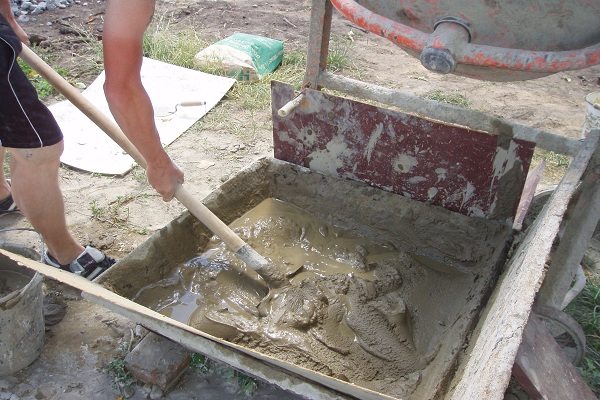When building garages, residential buildings or other outbuildings, cinder blocks are the cheapest building material. In addition, they have a number of good technological characteristics. But the most important thing is that you can make machines for the production of cinder blocks with your own hands, and produce blocks yourself.
General information about the cinder block
Cinder blocks are called building blocks, which are obtained in the process of vibrocompression or solidification of concrete mortar in the form. They are hollow and monolithic. The latter are durable and are more often used in the construction of foundations or as a material for cladding. The composition of the cinder block (as well as the foam block) is optimal for construction.
The cinder block solution may include: slag, ash, coal combustion waste. You can also add other ingredients to the mixture that are only available in your area. Including screenings of expanded clay, sand, brick waste, sawdust, gravel, perlite, and much more.
As a result, it is very profitable to make machines for cinder blocks with your own hands. Savings on building materials will be at least four times, since the market price for this building material is not small.
Form creation
First of all, you should decide what kind of machine you need. If you want to build a garage or a temporary hut, then a machine with two or even one mold is enough. If you are going to organize a small business, then you need a more productive machine, at least 3-4 matrices.
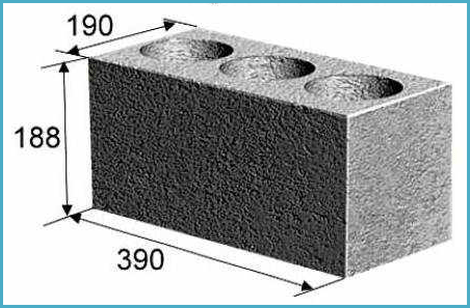
The most important part of the machine is the mold. The remaining parts and assemblies are additions that allow you to perform various manipulations with this form. For example - fill, lift, compact the solution, move, etc.
In the production of cinder blocks, the plant uses standard iron molds, as well as professional equipment that presses concrete into a mold under a weight of several tons. Do-it-yourself cinder block molds are most often made of wood. There are many types and designs.
In fact, the form is a container where the concrete is poured, and where it is until it solidifies completely. It should be noted that the forms must be collapsible so that the finished cinder block can be easily reached. In most cases, they are made even without a bottom, and a plate of material is placed under the bottom, to which concrete does not stick.
The easiest way to make voids in a block is to immerse plastic water bottles or glass champagne bottles in the soft concrete in the right place, which is preferable. But, if you want to set up a small production of cinder blocks with your own hands, then the blank formers must be fixed in the form.
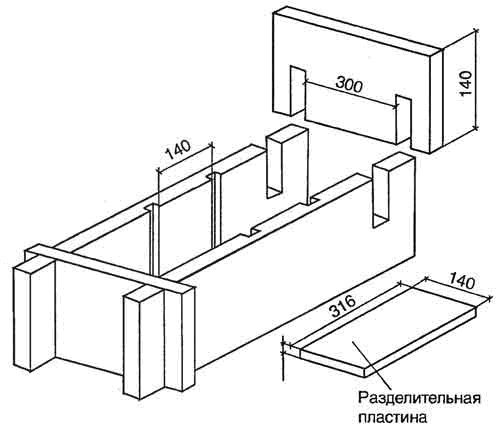
Related articles:
from wood
First of all, planed boards will be needed, the width of which will correspond to the height of the cinder block. Then you need to make the extreme crossbars, which will be connected to the longitudinal boards "sliding slots".
Then cuts are made from the inside of the longitudinal boards through a distance equal to the length of the cinder block. The transverse grooves must have a depth of 7 - 8 mm. The width of the cut corresponds to the thickness of the dividing plates, which can be made of iron, getinaks, textolite.
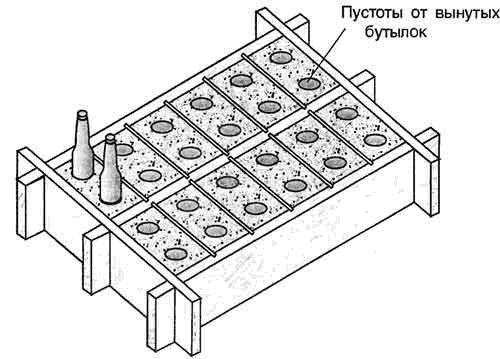
Plates can also be made from other sheet material, as long as it is smooth. In the drawing above, it is clear how to make wooden molds for cinder blocks with your own hands. It is desirable to open the details of the form with any oil paint. This will make it easier to remove the cinder blocks from the mold.
Please note that the sketch indicates smaller dimensions than the standard cinder block requires. Before creating the form, you can make drawings of the cinder block with your own hands. This procedure will not be superfluous and will not require a lot of work.
The above forms are used without a vibrator. The solution in them should be poured softer, with a high water content. However, with a little effort, you can create a more advanced, vibrating machine.
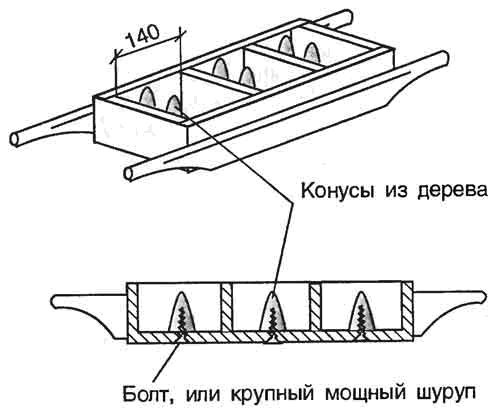
The molds for the vibrating table look a little different. It is necessary to attach handles to the sidewalls, for which two people can lift them and put them on the vibrating table. At the bottom of each cell should be two cones.
A form with a large number of cells should not be made, since such a stretcher will be very difficult to lift. Such forms are not dismantled, and cinder blocks are shaken out of them by overturning. The inner surfaces of the mold must be smooth so that the products can be easily removed.
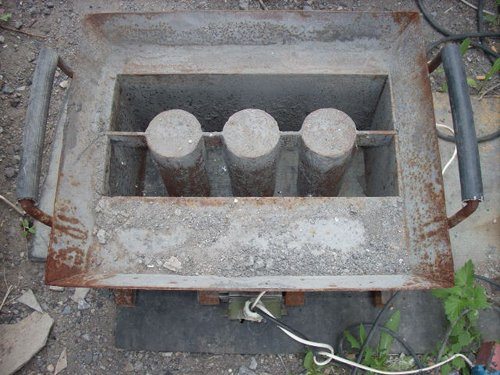
metal
When creating a machine for making cinder blocks with your own hands, you will need a steel sheet with a thickness 3-5 mm. Shape elements should be cut out of it based on the size of the cinder block. The standard is - 190x190x390 mm, in accordance with these dimensions, do-it-yourself drawings of cinder blocks are made. The height of the form should be 5 mm higher than the block so that the concrete mixture can be poured and pressed from above with a plate
Since the cinder block must be hollow, it is important to correctly make the void formers. The easiest way for these purposes is to use pipes. Please note that they need to be given a conical shape. Thanks to this, the product will be shaken out easily.
Blanks can be ordered from a turner to remove a few mm from one side of the pipe. Sometimes they make rectangular blanks. Their shape does not matter, the main thing is that they are conical. Keep in mind that the cinder block should be hollow no more than 30% .
Advice! The elements of the form should be welded to each other with tacks at a short distance so that the metal does not lead. Seams must be done on the outside so that even corners remain inside.
At the bottom of the mold along the perimeter, a wooden or rubber seal should be made to avoid deformation of the edges of the matrix. It is also possible to weld metal plates 20 mm wide along the edges.

Related articles:
Making a vibrating table
You can find paid drawings of machines on the Internet, but you should not waste your money. It is not at all difficult to make drawings of a machine for the production of cinder blocks with your own hands, based on those photographs and those materials that are distributed on the network for free.
The vibrating machine will allow you to produce cinder blocks much faster, since you do not have to wait a day until the solution dries. As a tabletop, you can use a sheet of metal. You will also need springs, for example, motorcycle.
In the middle of the tabletop, you need to attach the engine. It can be taken from an old washing machine. A pulley with an eccentric is installed on the motor shaft, which will ensure the vibration of the engine and, together with it, the entire platform, attached at the corners by springs over the tabletop.
Thus, you will make a vibrating table for a cinder block with your own hands - the most difficult part of the machine. All other details and improvements can be modified for themselves during operation. For example, wheels can be attached to the frame structure so that the machine can be conveniently moved.
Advice! A washer with a displaced center of gravity is suitable as an eccentric. It is also possible to weld a bolt with nuts perpendicular to the shaft.
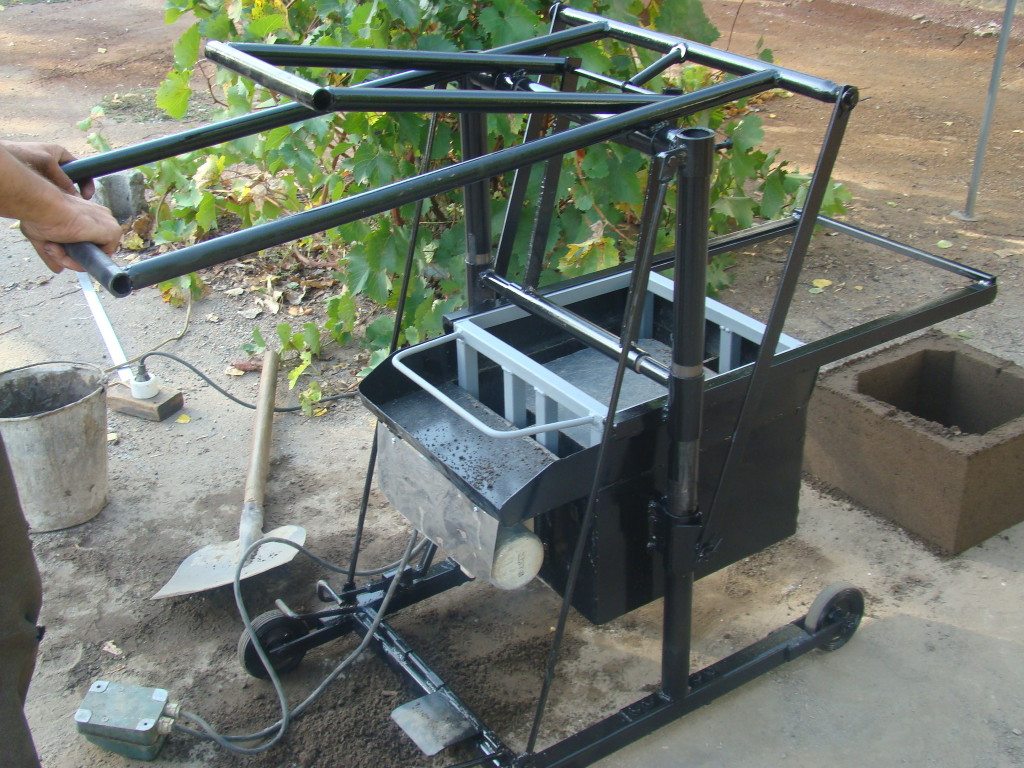
cinder block production
Vibration-free way
And so, the forms are ready, now it's time to try to make the first cinder block with your own hands. To do this, you must perform the following steps:
- First of all, the form must be placed on a flat surface. For this, a reinforced concrete slab or a metal sheet is suitable.
- The inner surfaces of the mold must be wiped with mining or diesel fuel. You can remove excess grease with a rag. Please note that after each pouring, it is necessary to wash the form of cement, dry it in the sun and re-lubricate.
- Forms must be half filled with a solution, and then placed in them bottles. They should not be immersed to the very end, leaving a gap of about 40 mm.
- After placing the bottles, it is necessary to bring the level of the solution to the edge of the equipment. The required amount of cement should be added to the mold with a trowel.
- After a few hours, you can remove the bottles. At the same time, they must be rotated around the axis so that the still weak solution does not stretch behind them.
- After 24 hours, the cinder blocks can be removed. To do this, you need to tap the shape around the perimeter with a hammer, and then disassemble it. The spacer plates should be tapped at a slight angle.
The use of empty formers, which in this case are bottles, will allow you to further reduce the cost of cinder blocks with your own hands. In addition, voids will improve the heat resistance of the future structure.
This method does not require vibrotamper or other compaction of the solution. At the same time, the product is so strong that it will not be easy to split it.
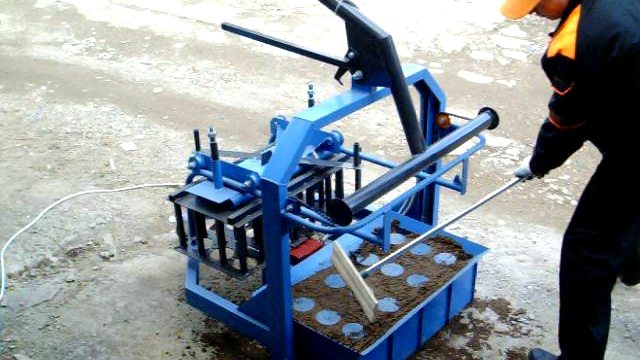
vibration method
This method is more productive. The instructions for making blocks are as follows:
- Forms must be placed on a vibrating table and filled with a solution.
- Turn on the engine for a few seconds.
- When the solution is compacted, it must be supplemented and the engine turned on for a few more minutes.
- After tamping, cinder blocks can be shaken out. However, it will be possible to move the product only after 4 hours.
Up to 300 cinder blocks can be produced per shift on such a vibrating machine.
